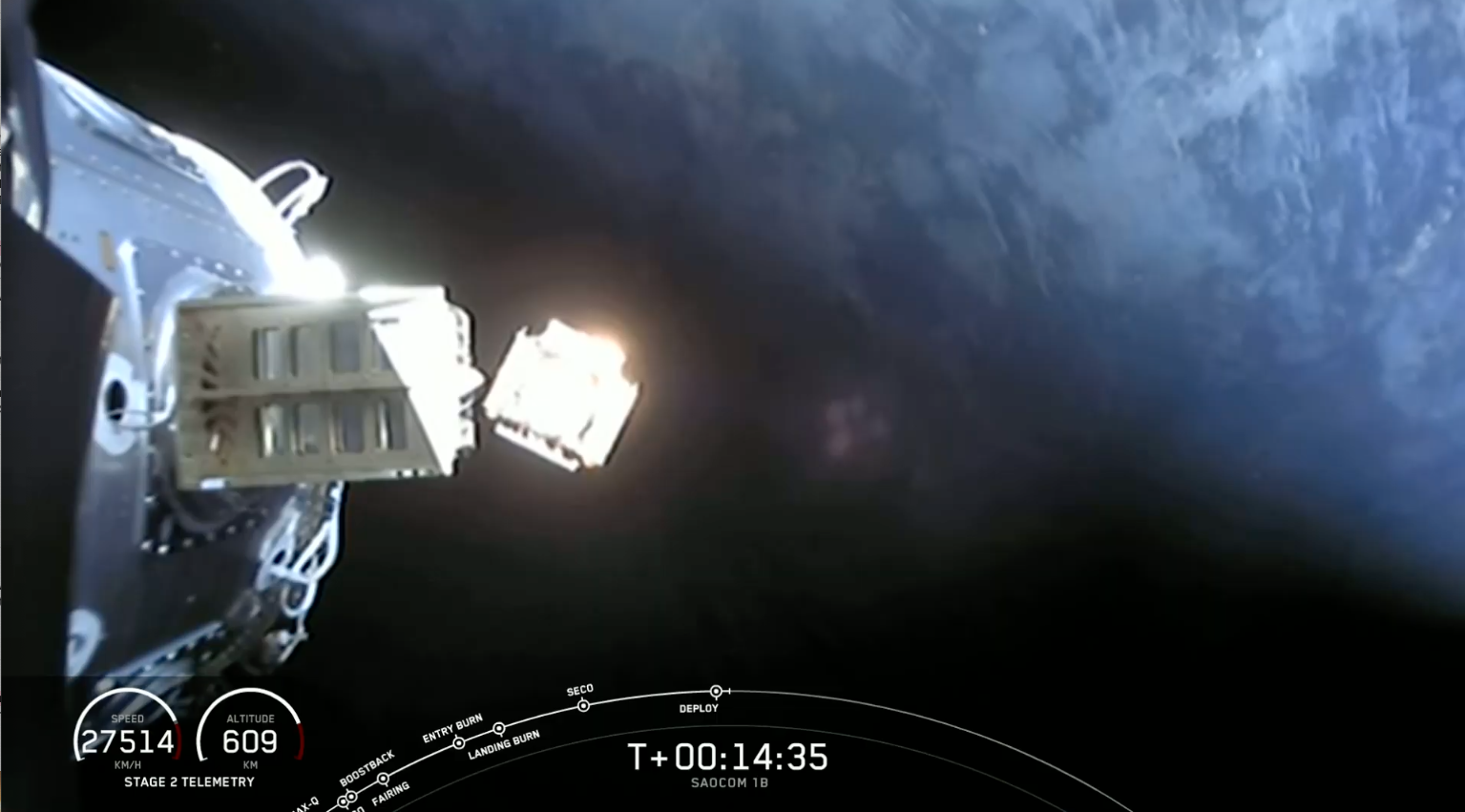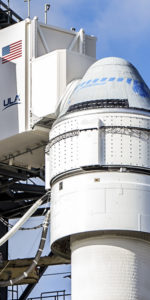
SpaceX has taken advantage of an anticipated week-long delay of the United Launch Alliance (ULA) Delta IV Heavy by launching Argentina’s SAOCOM-1B radar-imaging satellite atop a Falcon 9 booster from Space Launch Complex (SLC)-40 at Cape Canaveral Air Force Station, Fla. Liftoff of SpaceX’s 100th mission occurred at 7:18 p.m. EDT Sunday and the veteran B1059 core—the sixth Falcon 9 to fly as many as four times—successfully placed the satellite into orbit on the first polar mission from the Space Coast since February 1969.
And within eight minutes of leaving the ground, B1059 achieved SpaceX’s 20th landing of a rocket stage on solid ground in less than five years when it alighted on Landing Zone (LZ)-1 at the Cape.
Attention now turns to neighboring Pad 39A at the Kennedy Space Center (KSC), where another Falcon 9 stands primed to fly on 9:29 a.m. EDT Tuesday, laden with a 60-strong batch of Starlink low-orbiting internet communications satellites.
Hopes to fly as many as two Falcon 9s within a few hours of each other on Sunday—the Starlinks atop the previously-flown B1060 core at 10:12 a.m. EDT, followed by SAOCOM-1B at 7:18 p.m.—ultimately came to nothing, due to a worsening weather outlook. But it was nonetheless an audacious statement of intent from SpaceX.
“Pending Range availability, targeting back-to-back Falcon 9 launches from Florida on Sunday, 30 August,” tweeted SpaceX on Saturday. “Another flight of Starlink from LC-39A at 10:12 a.m. EDT, followed by the SAOCOM-1B mission from SLC-40 at 7:18 p.m. EDT.”

Attainment of this goal would mark the first time that SpaceX had launched two missions within the same 24-hour period. The previous record between its flights is 48 hours, set between the SSO-A SmallSat Express out of Vandenberg Air Force Base, Calif., and the CRS-16 Dragon cargo mission from the Cape, back in December 2018.
Sunday’s hoped-for but ultimately unrealized launch double-header came about following the last-second abort of a United Launch Alliance (ULA) Delta IV Heavy at 3:28 a.m. EDT Saturday. Laden with the highly secretive NROL-44 payload for the National Reconnaissance Office, this mission had already met with several days of frustrating delay related to the launch vehicle. Scrubbed at T-3 seconds in the small hours of Saturday morning—with the Delta IV Heavy’s characteristic hydrogen fireball generating a particularly dramatic effect—the ULA mission must wait at least a week before its next launch attempt.

The resultant opening-up of a window of time on the Eastern Range allowed SpaceX to target the resumption of an aggressive launch cadence on Sunday, with two Falcon 9s flying from separate Florida pads. B1060, previously utilized on the recent Global Positioning System (GPS) Block III launch on 30 June, would make its second flight to deliver the Starlinks to orbit, whilst SAOCOM-1B would ride atop B1059, making its fourth launch having flown most recently on 13 June.
In readiness for this impressive challenge, B1059 was transported out to SLC-40 and SpaceX confirmed it was vertical early Sunday. Interestingly, at the time of writing, neither of the two cores was put through a customary Static Fire Test of their nine Merlin 1D+ first-stage engines. That in itself has occurred before, on B1059’s most recent launch in June, but when it also occurred prior to SAOCOM-1B it marked the first time that no Static Fire Test has been performed ahead of the launch of a major commercial customer.
Weather conditions for Sunday’s two launch attempts were predicted to be marginal from the outset, with barely a 50-percent chance of acceptable conditions for the mid-morning Starlink flight and an even gloomier 40-percent likelihood for the SAOCOM-1B at the cusp of sunset. “Southwest flow impedes the inland progression of the East Coast sea-breeze and allows inland storms to migrate towards the Space Coast,” noted the 45th Weather Squadron at Patrick Air Force Base in its Sunday morning briefing. “This increases the threat of thunderstorms and associated cloudiness over the Spaceport.”
And with the remnants of Hurricane Laura adding their own “ample moisture” to the intractable Florida weather picture, there existed a bleak outlook dominated by the threat of violating the Thick Cloud Layers Rule, the Cumulus Cloud Rule and the Anvil Cloud Rule. With this in mind, unsurprisingly, early Sunday morning SpaceX formally scrapped its plan to launch the Starlink mission.

“Standing down from today’s launch of Starlink due to inclement weather during pre-flight operations,” it reported early Sunday morning. “Next launch opportunity is Tuesday, 1 September at 9:29 a.m. EDT, pending Range acceptance.”
Yet SpaceX had no intent—at least, not yet—to give up on its hope of getting SAOCOM-1B airborne on Sunday evening. (And as the weather closed in with its ominous threat of rain showers and storms, it seemed as if the launch would turn into a case of “Soak ’Em”, rather than “SAOCOM”.)
As has become customary in Falcon 9 Block 5 operations, fueling of the booster with liquid oxygen and a highly refined form of rocket-grade kerosene (known as “RP-1”) commenced at T-35 minutes. The SAOCOM-1B payload transitioned to internal power about 15 minutes before launch. And even the weather perked up and turned “Green” in the final minutes.


Liftoff occurred on time, less than a half-hour before local sunset, as B1059 powered smoothly uphill into beautiful skies on the 15th SpaceX mission of 2020. And within nine minutes, the core had completed its job and with pinpoint precision executed a boost-back and re-entry “burn” to alight on LZ-1 at the Cape, marking the 20th time a Falcon 9 has returned to land safely to solid ground since December 2015.
In the meantime, the second stage continued uphill, its Merlin 1D+ Vacuum engine burning for seven minutes and 40 seconds to deliver SAOCOM-1B towards polar orbit, with an inclination of 97.9 degrees to the equator. With polar-headed missions ordinarily flown out of Vandenberg Air Force Base, Calif., tonight’s flight marked the first of its type since February 1969. SpaceX noted that it had “worked closely” with the Air Force and the Federal Aviation Administration (FAA) to create a robust flight profile to ensure that the north-south trajectory could be accomplished safely.
Fourteen minutes after launch, Argentina’s 3,500-pound (1,600 kg) SAOCOM-1B—one of the largest satellites ever built in the Southern Hemisphere—was successfully deployed to begin its mission. Equipped with powerful L-band Synthetic Aperture Radar (SAR), it is tasked with conducting all-weather observations of Earth as part of ongoing efforts to mitigate the effects of natural disasters. Its twin, SAOCOM-1A, was launched into polar orbit from Vandenberg in October 2018, with an original expectation that SAOCOM-1B would do the same, before it was switched to a Florida launch.


Also hitching a ride uphill on this mission, and slated to deploy a little over an hour into the flight, were a pair of smaller payloads. The Global Navigation Satellite System (GNSS) Navigation and Occultation Measurement Satellite (GNOMES)-1, operated by Denver, Colo.-based PlanetiQ, aims to place a constellation of up to 20 microsats into orbit by 2023 for high-definition weather forecasting, climate research and space weather monitoring.
GNOMES-1 is equipped with PlanetiQ’s in-house-built Pyxis Global Positioning System (GPS) radio occultation payload for atmospheric sounding and is expected to operate at an altitude of almost 500 miles (800 km), inclined 72 degrees to the equator. The second rideshare payload, Tyvak-0172, is provided by Obispo, Calif.-headquartered Tyvak Nano-Satellite Systems, a provider of nanosatellite and CubeSat products.
.
.
FOLLOW AmericaSpace on Facebook and Twitter!
.
.





